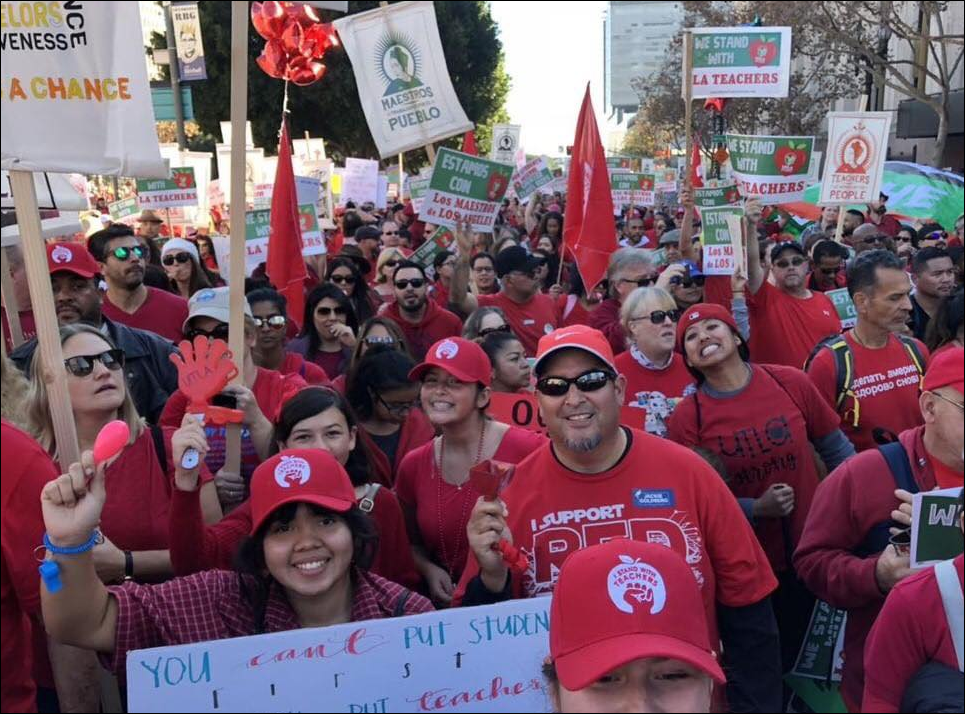Teachers protesting for higher pay and increased staffing in Los Angeles schools are flooding the city’s streets in a sea of red, members donning “Red for Ed” in a show of force that’s leaving students to fend for themselves.
The color has long been associated with teachers unions in the U.S., but it has a much deeper history rooted in the communist and socialist philosophies that underpin Big Labor’s politics in America today.
MORE NEWS: Know These Before Moving From Cyprus To The UK
The Communist Party of China explains why it chose red for the primary color of the country’s flag in 1942.
“The red color symbolizes revolution; the sickle and hammer are tools of workers and peasants, meaning the Communist Party of China represents the interests of the masses and people; the yellow color signifies brightness,” according to the CPC website.
“The red color is the symbol of revolution; the yellow hammer and sickle represents the tools of workers and peasants, symbolizing that the Communist Party of China is the pioneers (sic) of the working people and representing the fundamental interests of workers and the masses.”
The International Business Times highlighted the color’s importance to the far-left in a 2011 column on the 90th anniversary of the founding of the Communist Party of China.
China modeled its flag after communist Russia, spawning the “Red Scare” of encroaching communism in the west last century, but the color red “was associated with left-wing movements in Europe long before the Russian Revolution,” IBT reports.
“The flags associated with the European revolts in 1848 as well as the flag of the Italian nationalist Garibaldi were red – indeed his troops were called camicie rosse (redshirts). The flag of the Paris Commune of 1871 was also red,” according to the site.
MORE NEWS: How to prepare for face-to-face classes
“However, the red so prominent in the Russian and Chinese flags today are believed to relate to the blood of the workers – that is, to honor the suffering and sacrifices of the proletariat.”
The CWA Local 4202 details how Big Labor jumped on that theme to adopt red as its official color in 1989, when the union was on strike with Bell Atlantic.
“On August 15, 1989, Gerry Hogan, Chief Steward of CWA Local 1103, was killed. His death was a result of being run down by a ‘scab’ during the strike. In CWA’s long history, he is the only member to be killed walking the picket line,” according to the union website. “We asked all our members to wear RED on Thursdays to remind the Company of the blood they had spilled and to show support for our fallen brother. The idea started small and quickly spread across the nation. It was simple yet effective.”
Today’s unionized teachers in Los Angeles and elsewhere are now taking the theme and expanding it to education, drawing support from the socialist and communist organizations picketing alongside them. The Democratic Socialists of America created a GoFundMe page to offer “solidarity tacos” to folks toting picket signs in Los Angeles, while the Communist Party USA has also professed its support.
CPUSA contends the strike is about power and control of education in America, and preserving the union monopoly on education that’s failed students for decades.
“The larger picture that extends far beyond the classroom walls is that LAUSD has been a battleground for years as wealthy industrialists, investors and funders bankroll campaigns for seats on the school board, favoring charter school advocates who essentially aim to destroy public education and the powerful teachers unions,” CPUSA wrote in a feature on its website. “It’s an attack on the commonwealth that echoes throughout the United States.”
In the last decade, states across the country have rolled back union privileges that have drained public school resources for years, from right to work legislation in Michigan to Wisconsin’s Act 10 and reforms in Indiana that limited union negotiations. The changes saved taxpayers billions through things like eliminating government-subsidized salaries for union officials, giving schools the freedom to shop for cheaper health insurance, and greater control over leave and sick time policies, among others.
In many places, educators were also freed to choose whether or not to join the union, as it was previously a condition of employment. Professional educators bailed in droves, with many citing their union’s far left politics as their main motivation.
More recently, the U.S. Supreme Court has extended the right to choose union membership to the entire nation, and teachers unions launched an offensive across the country to salvage their remaining clout, which has dominated state politics in America for decades.
The strike in Los Angeles represents the latest high-profile “battle.” On one side, the teachers union is locked arm-in-arm with socialists and communists focused on maintaining the failing union monopoly on public schools. On the other, parents, education reform advocates, administrators, substitutes working to keep schools open, community leaders and others are more focused on what students need.
As UTLA President Alex Caputo-Pearl put it, it’s “a fight for the soul of public education.”


Join the Discussion
Comments are currently closed.